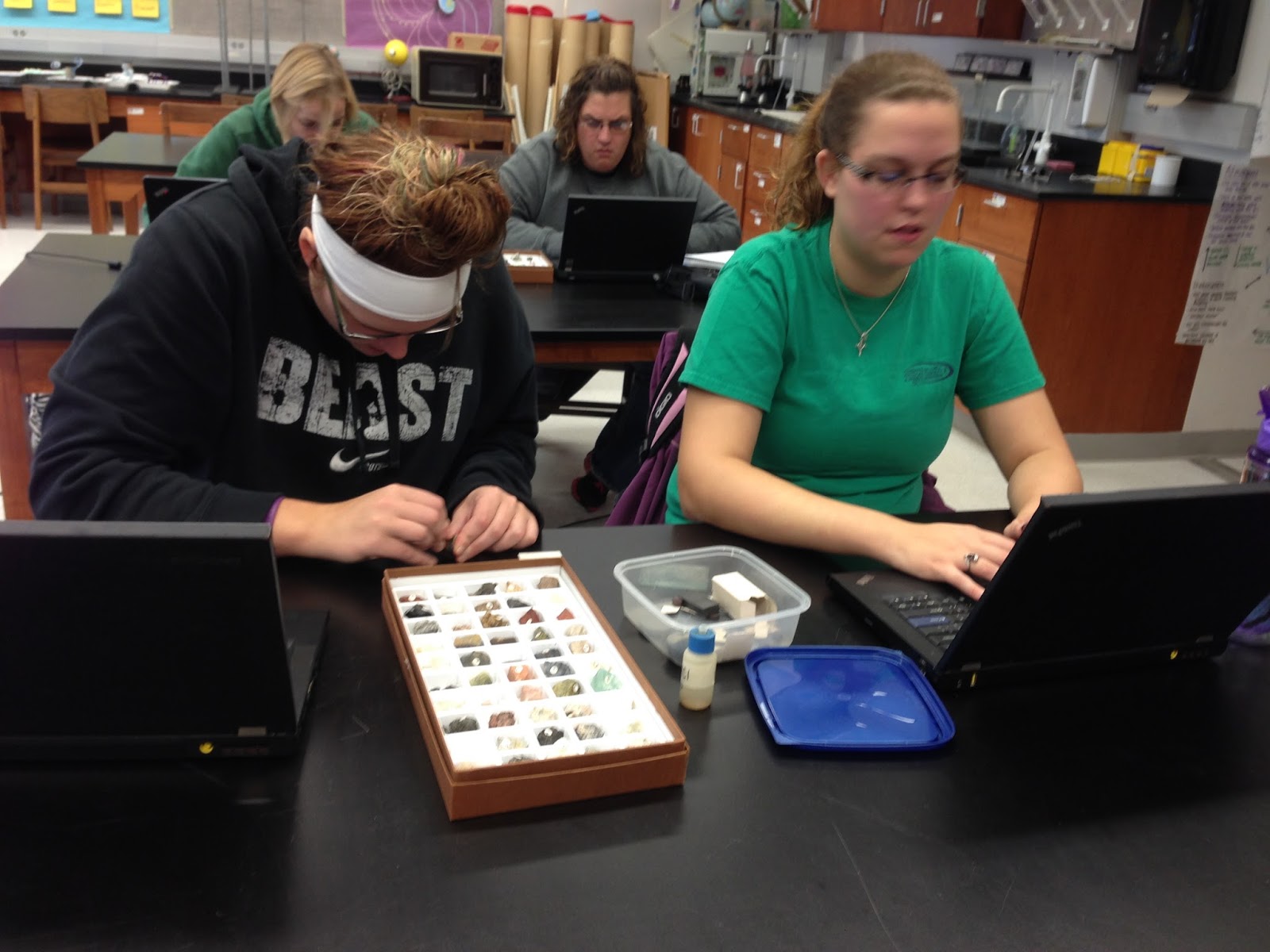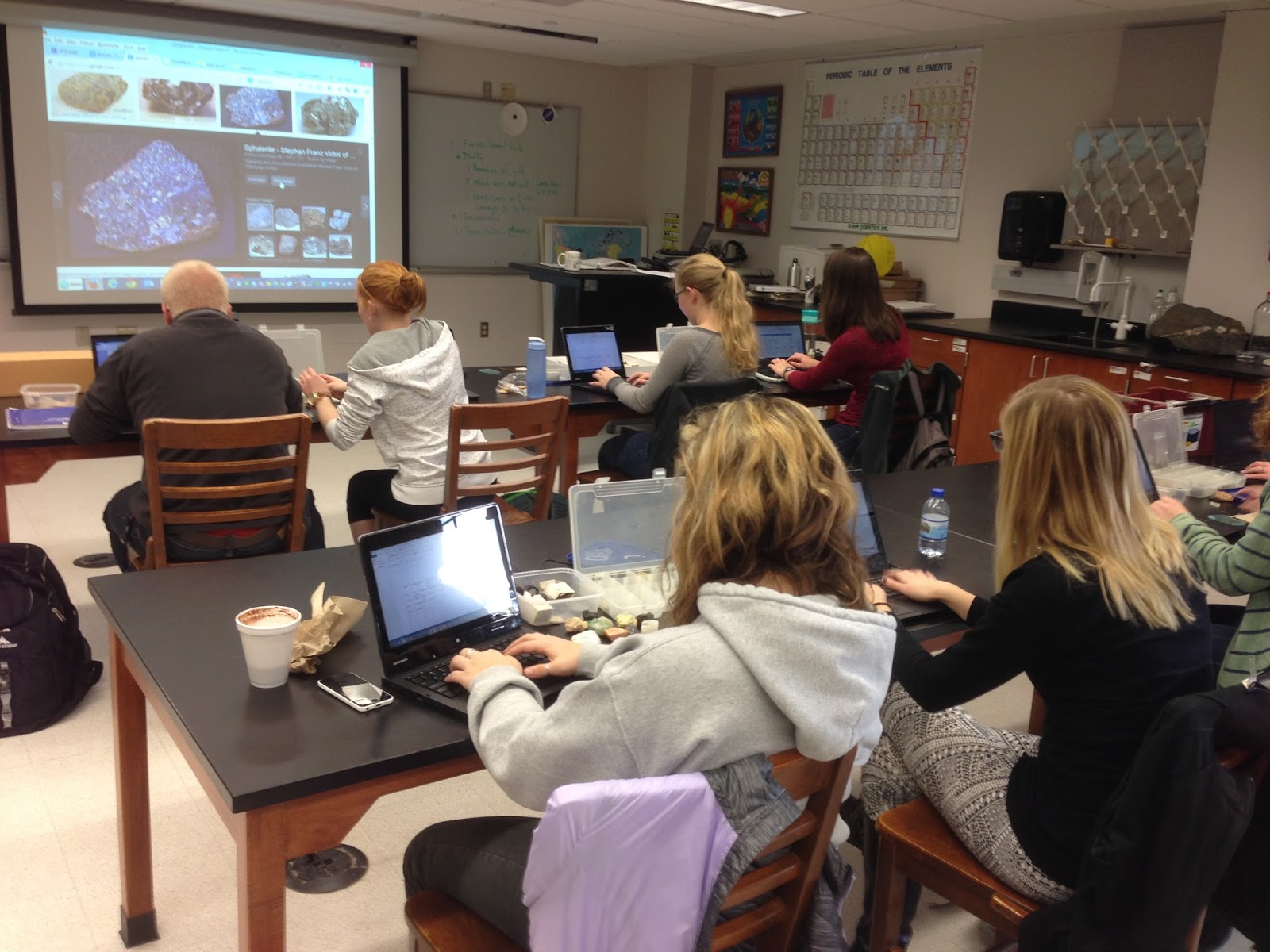The Rock Cycle
http://www.k5chalkbox.com/sedimentary-rock-formation.html .
Edible Igneous Rocks
http://www.pages.drexel.edu/~ks73/Ediblerocks.htm
Students simulate the rock cycle and end up with igneous rock fudgehttp://lessonplanspage.com/ScienceRockCycleFudge58.htm/
This is a great activity that reinforces the basic concepts of how sedimentary rock is formed. It takes a bit of preparation but makes a big impact.
http://www.primary-education-oasis.com/sedimentary-rock-formation.html
Edible Geology provides students with an easy way to remember the basic characteristics of Franciscan Complex rocks, and to enable students to connect their prior knowledge of common candies with the descriptive science of geology.
http://www.nps.gov/goga/forteachers/loader.cfm?csModule=security/getfile&PageID=159403
This is a chronicle of teaching Earth System Science and Educational Technology at NMU. http://www.nmu.edu
Friday, October 31, 2014
Wednesday, October 29, 2014
More on Minerals and Cookie Mining.
Minerals and Cookie Mining.
Cookie Mining: Grades 3-8
Concept:
Coal deposits, like many natural resources, are unevenly distributed throughout the world.
Mining, like other methods used to extract natural resources, affect the environment to varying degrees.
Many factors need to be considered when making decisions regarding the wise use of natural resources.
Objective:
• Recognize that use decisions are complex.
• Learn that mining has environmental considerations that need to be addressed.
Standards:
•ENERGY
Understand energy, its transformations, and interactions with matter
Identify forms of various types of energy and their effects on matter.
Describe examples of energy transfer.
•THE DYNAMIC EARTH
Understand the properties and limited availability of the materials, which make up the Earth.
Identify properties and uses of Earth materials.
Recognize that Earth materials are used in different ways based on differences in their physical and chemical properties.
Somewhere, over the rainbow
Cookie Mining: Grades 3-8
Concept:
Coal deposits, like many natural resources, are unevenly distributed throughout the world.
Mining, like other methods used to extract natural resources, affect the environment to varying degrees.
Many factors need to be considered when making decisions regarding the wise use of natural resources.
Objective:
• Recognize that use decisions are complex.
• Learn that mining has environmental considerations that need to be addressed.
Standards:
•ENERGY
Understand energy, its transformations, and interactions with matter
Identify forms of various types of energy and their effects on matter.
Describe examples of energy transfer.
•THE DYNAMIC EARTH
Understand the properties and limited availability of the materials, which make up the Earth.
Identify properties and uses of Earth materials.
Recognize that Earth materials are used in different ways based on differences in their physical and chemical properties.
Friday, October 24, 2014
Mineral Identification
Minerals
http://facweb.bhc.edu/academics/science/harwoodr/Geol101/Labs/Minerals/
Minerals are defined as naturally occurring, inorganic, solids with a definite chemical composition and a regular, internal crystalline structure. The keys to this definition are the chemical composition and the crystalline structure. Different chemical compositions result in different minerals.
Physical Properties
Determination of the actual chemical composition and crystalline structure of a mineral is difficult without the proper equipment. In an introductory level lab it is impossible for us to determine these two aspects of a mineral.Crystal Form
http://geomaps.wr.usgs.gov/parks/rxmin/mineral.htmlhttp://pubs.usgs.gov/of/2001/0360/
http://pubs.usgs.gov/of/2000/0144/
Thursday, October 23, 2014
Finishing Fossils and Starting Minerals
Finishing Fossils and Starting Minerals
Mrs Stewert's Crystal Garden Supplies:
http://engineering.oregonstate.edu/momentum/k12/june04/
http://www.instructables.com/id/Grow-your-own-Magic-Crystal-Tree-or-any-other-sha/ http://chemistry.about.com/cs/growingcrystals/ht/charcoalgarden.htm
Mrs Stewert's Crystal Garden Supplies:
- 1 container (per child) – plastic (clear polystyrene) to-go dishes work well
- Several small pieces of porous material to grow on per container – sponges, clay pot pieces, BBQ Briquettes, etc.
- Water
- Ammonia
- Laundry Bluing (such as Mrs. Stewart’s Liquid Bluing…careful it stains!)
- Salt
- 1 small paper cup to mix ingredients (Dixie Cup)
- 1 plastic spoon
- Food Coloring (optional)
http://engineering.oregonstate.edu/momentum/k12/june04/
http://www.instructables.com/id/Grow-your-own-Magic-Crystal-Tree-or-any-other-sha/ http://chemistry.about.com/cs/growingcrystals/ht/charcoalgarden.htm
Wednesday, October 15, 2014
Geologic Time: Making Fossils
Fossils are ancient remnants of once living things. They are our only link to the living past. They tell us of ancient environments and organism habits. Many times they are used to help distinguish periods of geologic time. The absence of fossils in rock can make it difficult to be sure what took place in the past.
Trace fossils are the most common fossils found in nature. They are impressions left in the sediment from once living things. Common trace fossils are footprints or walkways, resting spots, living burrows, feeding burrows, casts and molds. They are not the original parts of an animal. A trace fossil is preserved when mud or dirt that was disturbed by something living hardens and keeps its shape.
There are two main kinds of trace fossils, molds and casts. A mold forms when something is pressed into soft mud and removed by decomposition or pulled out, leaving an impression of the object. A cast is a 3-D example of an object of the past created when a mold fills up with sediment like mud, sand or volcanic ash.
http://www.nps.gov/brca/forteachers/paleoact4.htm
Homemade Geology Dig Kit
I grabbed up some cool rocks, gems, & fossils and made him a “dig block,” he can enjoy. It’s really simple and inexpensive. I already had plaster of Paris & sand laying around.
Materials for Dig Block:
Plaster of Paris / Throwaway Container for mixing / Mixing stick
Sand
Cinnamon
Shoebox Sized Container or foil pan as a mold
Objects to ‘hide’ in the block
Making the Dig Block:
For the mold, I used a small foil loaf pan. It worked great. At the end, the block slid right out of it.
http://happytrailswildtales.com/2012/11/homemade-geology-dig-kit/
Friday, October 10, 2014
Radiometric Dating
Content/concepts goals for this activity:
http://serc.carleton.edu/NAGTWorkshops/time/activities/60525.html
- Probabilistic nature of radioactive decay
- Importance of sample size
- Time limits to effectiveness of radiometric dating
Higher order thinking skills goals for this activity
- Observation and explanation of the differences between real events and probabilistic models
- Extending understanding of this simulation to radiometric dating
Other skills goals for this activity
- Graphing and probability
http://vertpaleo.org/PDFS/91/91d355f2-4cf0-43bb-bff7-64f033fd79ac.gif
Subscribe to:
Comments (Atom)
















































.aspx.gif)
